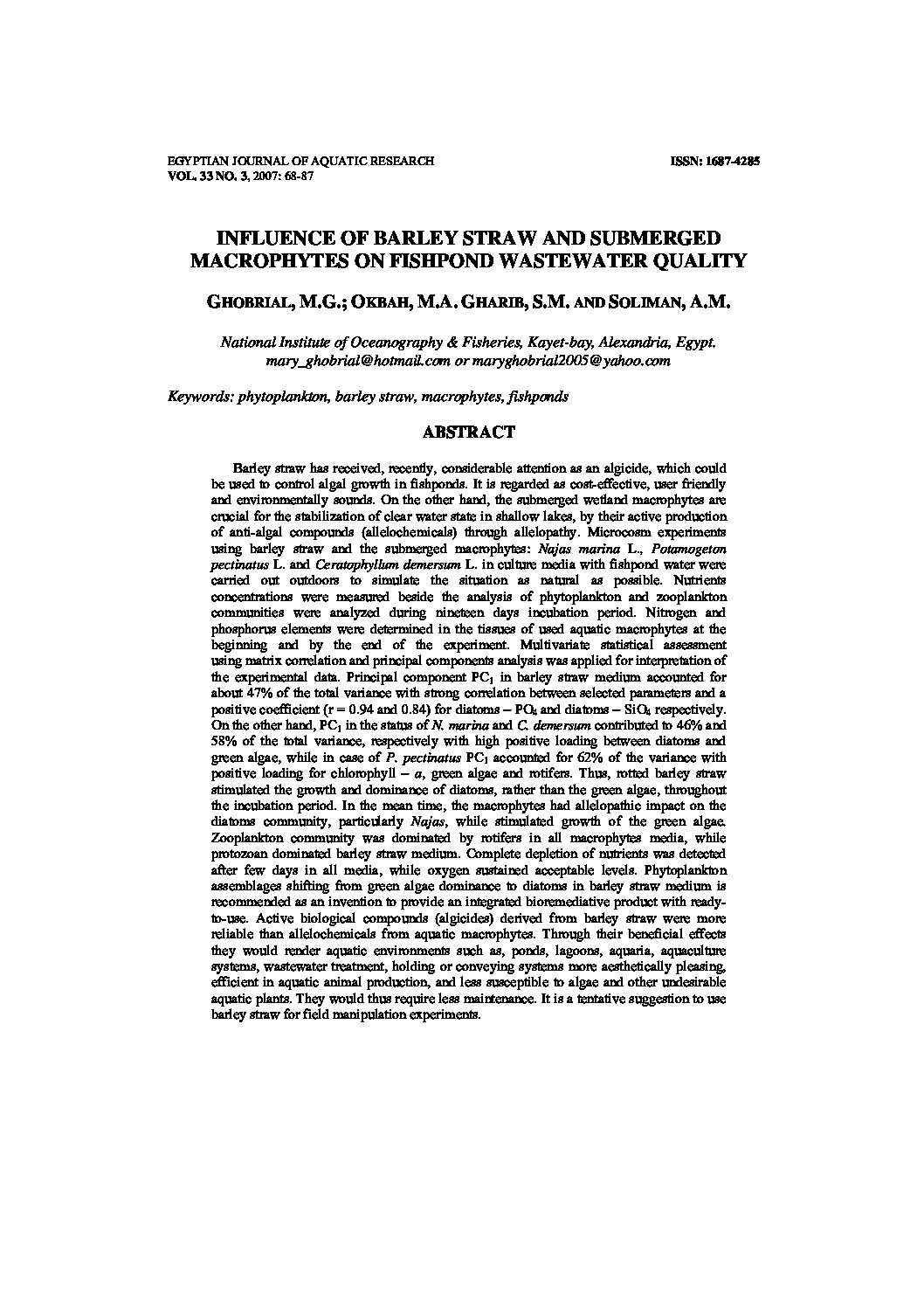Categories
vol-33INFLUENCE OF BARLEY STRAW AND SUBMERGED
MACROPHYTES ON FISHPOND WASTEWATER QUALITY
GHOBRIAL, M.G.; OKBAH, M.A. GHARIB, S.M. AND SOLIMAN, A.M.
National Institute of Oceanography & Fisheries, Kayet-bay, Alexandria, Egypt.
[email protected] or [email protected]
Keywords: phytoplankton, barley straw, macrophytes, fishponds
ABSTRACT
Barley straw has received, recently, considerable attention as an algicide, which could
be used to control algal growth in fishponds. It is regarded as cost-effective, user friendly
and environmentally sounds. On the other hand, the submerged wetland macrophytes are
crucial for the stabilization of clear water state in shallow lakes, by their active production
of anti-algal compounds (allelochemicals) through allelopathy. Microcosm experiments
using barley straw and the submerged macrophytes: Najas marina L., Potamogeton
pectinatus L. and Ceratophyllum demersum L. in culture media with fishpond water were
carried out outdoors to simulate the situation as natural as possible. Nutrients
concentrations were measured beside the analysis of phytoplankton and zooplankton
communities were analyzed during nineteen days incubation period. Nitrogen and
phosphorus elements were determined in the tissues of used aquatic macrophytes at the
beginning and by the end of the experiment. Multivariate statistical assessment
using matrix correlation and principal components analysis was applied for interpretation of
the experimental data. Principal component PC1 in barley straw medium accounted for
about 47% of the total variance with strong correlation between selected parameters and a
positive coefficient (r = 0.94 and 0.84) for diatoms – PO4 and diatoms – SiO4 respectively.
On the other hand, PC1 in the status of N. marina and C. demersum contributed to 46% and
58% of the total variance, respectively with high positive loading between diatoms and
green algae, while in case of P. pectinatus PC1 accounted for 62% of the variance with
positive loading for chlorophyll – a, green algae and rotifers. Thus, rotted barley straw
stimulated the growth and dominance of diatoms, rather than the green algae, throughout
the incubation period. In the mean time, the macrophytes had allelopathic impact on the
diatoms community, particularly Najas, while stimulated growth of the green algae.
Zooplankton community was dominated by rotifers in all macrophytes media, while
protozoan dominated barley straw medium. Complete depletion of nutrients was detected
after few days in all media, while oxygen sustained acceptable levels. Phytoplankton
assemblages shifting from green algae dominance to diatoms in barley straw medium is
recommended as an invention to provide an integrated bioremediative product with readyto-use. Active biological compounds (algicides) derived from barley straw were more
reliable than allelochemicals from aquatic macrophytes. Through their beneficial effects
they would render aquatic environments such as, ponds, lagoons, aquaria, aquaculture
systems, wastewater treatment, holding or conveying systems more aesthetically pleasing,
efficient in aquatic animal production, and less susceptible to algae and other undesirable
aquatic plants. They would thus require less maintenance. It is a tentative suggestion to use
barley straw for field manipulation experiments.







